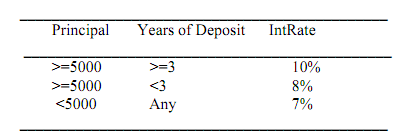PROGRAM TO FIND INTEREST ON BANK DEPOSITS:
We have to write a program to find interest on deposits. The criteria is given below :

identification division.
program- id.
environment division.
input-output section.
file-control.
select bankfile assign to disk
organization is line sequential.
data division.
file section.
fd bankfile
label records are standard
value of file- id is "bank.dat".
01 bankrec.
02 dno pic 9(5).
02 dname pic x(21).
02 p pic 9(4)v9(2).
02 n pic 9(2).
working-storage section.
01 ans pic x value space.
01 tot pic 9(6)v9(2) value 0.
01 int pic 9(6)v9(2) value 0.
01 key- in pic x value space.
01 r pic 9(2) value 0.
01 head-1 pic x(80) value all '-'.
01 head-2.
02 f pic x(8) value "Deps No".
02 f pic x(3) value spaces.
02 f pic x(10) value "Deps Name".
02 f pic x(5) value spaces.
02 f pic x(8) value "Deposit".
02 f pic x(5) value spaces.
02 f pic x(8) value "Period".
02 f pic x(5) value spaces.
02 f pic x(5) value "Rate".
02 f pic x(5) value spaces.
02 f pic x(8) value "Interest".
02 f pic x(10) value " Nett".
01 head-3.
02 e-dno pic z(5).
02 e-dname pic x(26).
02 e-p pic z(4).z(2).
02 f pic x(5) value spaces.
02 e-n pic z(2).
02 f pic x(5) value spaces.
02 e-r pic z(2).
02 f pic x(3) value spaces.
02 e-int pic z(4).z(2).
02 f pic x(3) value spaces.
02 e-tot pic z(6).z(2).
procedure division.
p-1.
open output bankfile.
perform g-w-para until ans = 'N' or 'n'.
close bankfile.
open input bankfile.
display(1 1) erase.
display head-1.
display head-2.
display head-1.
read-para.
read bankfile at end go to close-para.
if ( p not < 5000 and n not < 3 )
move 10 to r
compute tot = p * (1 + r / 100) ** n.
if ( p not < 5000 and n < 3)
move 8 to r
compute tot = p * (1 + r / 100) ** n.
if ( p < 5000)
move 7 to r
compute tot = p * (1 + r / 100) ** n.
move tot to e-tot.
compute int = tot - p.
move int to e- int.
move dno to e-dno.
move dname to e-dname.
move p to e-p.
move n to e-n.
move r to e-r.
display head-3.
go to read-para.
close-para.
display head-1.
close bankfile.
stop run.
g-w-para.
display(1 1) erase.
display(3 5) "Dep No : ".
accept dno.
display(5 5) "Dep Name : ".
accept dname.
display(7 5) "Amount : ".
accept p.
display(9 5) "Years : ".
accept n.
write bankrec.
display(15 5) "Add more [y/n] : ".
accept ans.